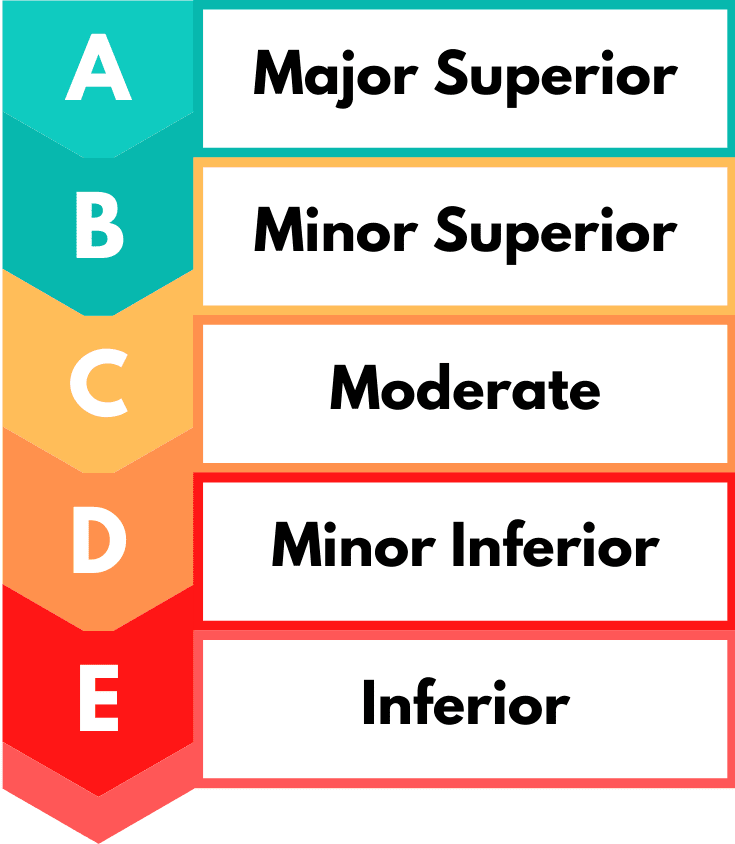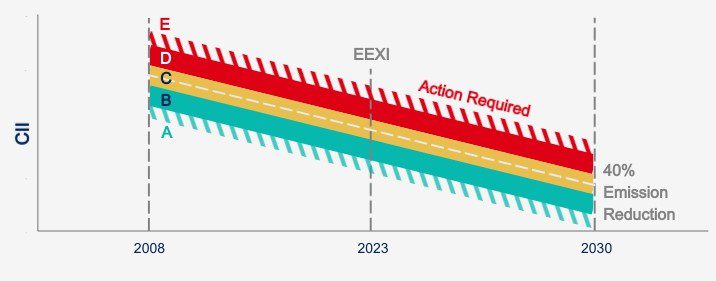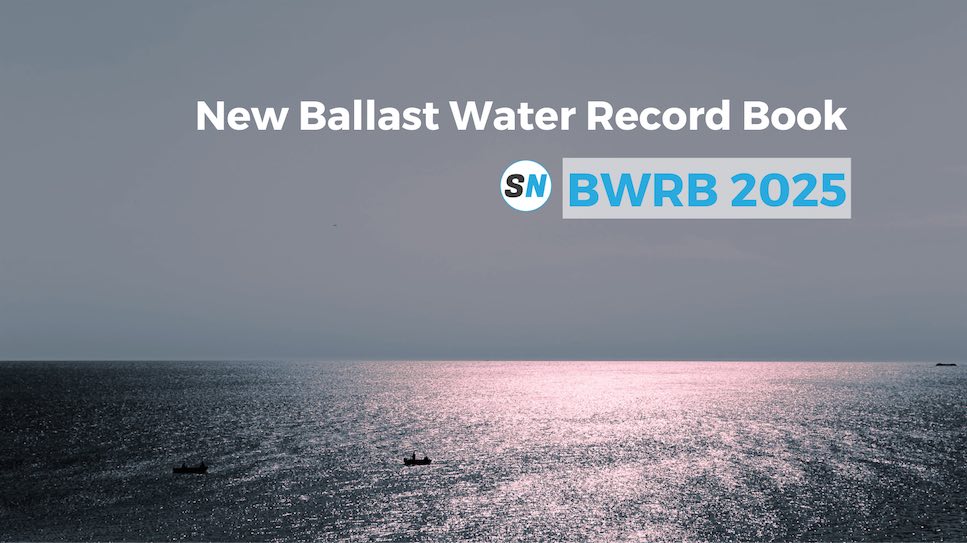21 December 2024
CII Calculation: Carbon Intensity Indicator Guide

The Carbon Intensity Indicator, CII calculation is one of the top hits in the past month. Thus, we debunk its complexity by simplifying the procedures based on IMO guidelines.
Table of Contents
Definition
The operational measure accompanying EEXI is the Carbon Intensity Indicator (CII), which evaluates the transport efficiency of vessels. Particularly, it will be applicable to all cargo, RoPax, and cruise ships above 5,000 GT. Moreover, the estimation of this index incorporates the annual ship’s fuel consumption, the distance traveled, and the capacity. Hence, CII results in emitted CO2 per cargo carrying capacity for the annual traveled distance. Based on the result, the vessel will have a rating between A – E.


SEEMP involvement
A part of the CII regulation is to include mandatory content in the enhanced SEEMP. Thus, ensuring continuous improvement of energy efficiency and lower carbon intensity.
The enhanced SEEMP shall include an implementation plan advising how to achieve the CII targets, and it will also be subject to approval and company audits. For ships that achieve a D rating for three consecutive years or an E rating in a single year; operators need to develop a “Plan of Corrective Actions” as part of the SEEMP and get approval.

SEEMP (Part I, II, III) – Everything you need to know
From the year 2023, the ships subject to the CII rating will have to develop a SEEMP Part 3 (III) on or before 31 December 2022.
Ship Nerd
CII Calculation
In principle, CII calculation is a more straightforward method compared to EEXI/EEDI. However, complexity stands up when it comes to newbuilds. In this case, owners have to predict and minimize the CII value as much as possible.
The energy modeling of the vessel will allow the simulation specific to the particular operating profile. These models also account for potential environmental conditions a vessel may come across while at sea. Hence, allowing the shipowner to achieve a better rating. However, the CII value will still not be completely accurate but for sure will bring us a step closer to the desired results.
Attained CII
Note that, in its most simple form, the attained annual operational CII of individual ships is calculated as the ratio of the total mass of CO2 (M) emitted to the total transport work (W) undertaken in a given calendar year.
Mass of CO2 emissions
Where:
Transport Work
Where:
Capacity, represents the deadweight tonnage (DWT) of the vessel. For cruise passenger ships, ro-ro cargo ships (vehicle carriers), and ro-ro passenger ships, we use gross tonnage (GT) instead.
Distance, is the traveled nautical miles (NM) as reported under IMO DCS.
Amendments
Following the MEPC 78, held during 6-10 June 2022, new guideline (G5) adopted. Specifically, this includes correction factors and voyage adjustments for various ship types and circumstances. Particularly, there was an extensive discussion on which corrections and adjustments to include. But,corrections for adverse weather and extensive port and waiting time were not included at this stage and will need to be raised at the review in 2025. Hence, the correceted attained CII is as follows:
Voyage Adjustment
– FCvoyage, j is the mass (in grams) of fuel of type 𝑗, consumed in voyage periods during the calendar year which may be deducted according to paragraph 4.1 of guidelines;
– 𝑇𝐹𝑗 = (1 − 𝐴𝐹𝑇𝑎𝑛𝑘𝑒𝑟 ) ⋅ 𝐹𝐶𝑆,𝑗 represents the quantity of fuel j removed for STS or shuttle tanker operation,
where 𝐹𝐶𝑆,𝑗 = 𝐹𝐶𝑗 for shuttle tankers and 𝐹𝐶𝑆,𝑗 is the total quantity of fuel j used on STS voyages for STS vessels.
If 𝑇𝐹𝑗 > 0 then 𝐹𝐶𝑒𝑙𝑒𝑐𝑡𝑟𝑖𝑐𝑎𝑙,𝑗 = 𝐹𝐶𝑏𝑜𝑖𝑙𝑒𝑟,𝑗 = 𝐹𝐶𝑜𝑡ℎ𝑒𝑟𝑠,𝑗 = 0;
– 𝐴𝐹𝑇𝑎𝑛𝑘𝑒𝑟 represents the correction factor, applied to Shuttle tankers or STS voyages according to paragraph 4.2 of the guidelines;
Correction Factors
– 𝑦𝑖 is a consecutive numbering system starting at 𝑦2023 = 0, 𝑦2024 = 1, 𝑦2025 = 2, etc;
– 𝐹𝐶𝑒𝑙𝑒𝑐𝑡𝑟𝑖𝑐𝑎𝑙,𝑗 is the mass (in grams) of fuel type 𝑗, consumed for production of electrical power which is deductable according to paragraph 4.3 of the guidelines;
– 𝐹𝐶𝑏𝑜𝑖𝑙𝑒𝑟,𝑗 is the mass (in grams) of fuel type 𝑗, consumed by the boiler for the purposes of cargo heating and cargo discharge on tankers;
– 𝐹𝐶𝑜𝑡ℎ𝑒𝑟𝑠,𝑗 is the mass (in grams) of fuel type 𝑗, consumed by other related fuel consumption devices according to paragraph 4.5 of the guidelines;
– Capacity correction factor for ice-classed ships, 𝑓𝑖;
– Factor for ice-classed ships having IA Super and IA, 𝑓𝑚;
– Cubic capacity correction factors for chemical tankers, 𝑓𝑐;
– Correction factor for ship specific voluntary structural enhancement, 𝑓𝑖,𝑉𝑆𝐸;
– 𝐷𝑡 represents the total distance travelled (NM), as reported under IMO DCS;
– 𝐷𝑥 represents distance travelled (NM) for voyage periods which are deductable from CII calculation according to paragraph 4.1 of the guidelines.
Note that, all correction factors are specified in the 2018 Guidelines on the method of calculation of the attained EEDI for new ships (resolution MEPC.308(73) as amended by resolution MEPC.322(74)).
Hence, vessels can correct the CII rating based on their actual operation. For instance, a chemical tanker that consumes most fuel on discharging cargo, will be able to deduct this amount from the emitted CO2 emmissions.
Reference Value
Given that the limited data available for the year of 2008, the operational carbon intensity performance of ship types in year 2019 is taken as the reference.
Where, a and c are parameters, estimated through median regression fits, taking the attained CII and the Capacity of individual ships collected through IMO DCS in year 2019 as the sample. The parameters for determining the ship type specific reference lines, for use in above equation, are specified in Table 1 of Guidelines (G2).
Required CII
Moreover, in accordance with regulation 28 of MARPOL Annex VI, the calculation of the required annual operational CII for a ship follows the below.
Where, Z is a general reference to the reduction factors for the required annual operational CII of ship types from year 2023 to 2030, as specified in Table 1 of Guidelines (G3). Consequently, if the vessel maintain the same emission score, the rating will be slightly worse year by year.
CII Rating
At last, to facilitate the rating assignment, for each year from 2023 to 2030, there are four boundaries for the five-grade rating mechanism. Thus, a rating can be assigned through comparing the attained annual operational CII of a ship with the boundary values.
Hence, by calculating the above ratio, we can obtain the final operational carbon intensity indicator. Then by comparing the boundaries annotated on Table 1 of the Guidelines (G4) the vessel assigns to its rating.
Controlling the Rating
Thus, the CII is based directly on the fuel consumption, influenced by how a specific ship operates in combination with its technical efficiency. Its value vary with the type of fuel used, the efficiency of the vessel and operational parameters such as; vessel speed, cargo transported, weather conditions and the general condition of the vessel (e.g. biofouling).

How energy-saving technologies can help CII rating
How can energy-saving technologies, also referred to as energy-saving devices, help you comply with CII? If you want hard data and real-world examples from vessel operators, a recent webinar is a must.
Ship Nerd
Therefore, owners can control the CII by optimizing operations and ensuring vessels are in a good condition. Charterers will have a major influence over the CII of the ships by selecting the speed. Therefore, it will be beneficial for owners/operators to continuously monitor the CII performance of the vessel to avoid having to take drastic measures unexpectedly.
See Also

What is the new GHG Rating for ships by RightShip?
RightShip’s Greenhouse Gas (GHG) Rating is a tool to compare the CO2 emissions of vessels globally that continuously becomes more attractive.


